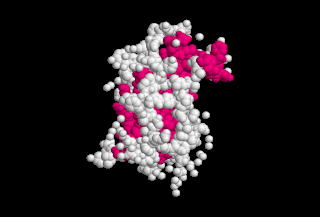Related Research Articles

Turner syndrome (TS), also known as 45,X, or 45,X0, is a genetic condition in which a female is partly or completely missing an X chromosome. Signs and symptoms vary among those affected. Often, a short and webbed neck, low-set ears, low hairline at the back of the neck, short stature, and swollen hands and feet are seen at birth. Typically, they develop menstrual periods and breasts only with hormone treatment, and are unable to have children without reproductive technology. Heart defects, diabetes, and low thyroid hormone occur more frequently. Most people with TS have normal intelligence; however, many have troubles with spatial visualization that may be needed for mathematics. Vision and hearing problems occur more often.

Say–Meyer syndrome is a rare X-linked genetic disorder that is mostly characterized as developmental delay. It is one of the rare causes of short stature. It is closely related with trigonocephaly. People with Say–Meyer syndrome have impaired growth, deficits in motor skills development and mental state.

Dwarfism occurs when an organism is exceptionally small. In humans, it is sometimes defined as an adult height of less than 147 centimetres, regardless of sex; the average adult height among people with dwarfism is 122 centimetres, although some individuals with dwarfism are slightly taller. Disproportionate dwarfism is characterized by either short limbs or a short torso. In cases of proportionate dwarfism, both the limbs and torso are unusually small. Intelligence is usually normal, and most have a nearly normal life expectancy. People with dwarfism can usually bear children, although there are additional risks to mother and child, dependent upon the underlying condition.
Short stature refers to a height of a human which is below typical. Whether a person is considered short depends on the context. Because of the lack of preciseness, there is often disagreement about the degree of shortness that should be called short. Dwarfism is the condition of being very short, often caused by a medical condition.
Trisomy 8 causes Warkany syndrome 2, a human chromosomal disorder caused by having three copies (trisomy) of chromosome 8. It can appear with or without mosaicism.
The short-stature homeobox gene (SHOX), also known as short-stature-homeobox-containing gene, is a gene located on both the X and Y chromosomes, which is associated with short stature in humans if mutated or present in only one copy (haploinsufficiency).
Abruzzo–Erickson syndrome is a condition that may present with deafness, protruding ears, coloboma, a cleft palate or palatal rugosity, and short stature.
Aarskog–Scott syndrome is a rare disease inherited as X-linked and characterized by short stature, facial abnormalities, skeletal and genital anomalies. This condition mainly affects males, although females may have mild features of the syndrome.

Laron syndrome (LS), also known as growth hormone insensitivity is an autosomal recessive disorder characterized by a lack of insulin-like growth factor 1 production in response to growth hormone. It is usually caused by inherited growth hormone receptor (GHR) mutations.

"Napoleon complex" is a theorized inferiority complex normally attributed to people of short stature. It is characterized by overly-aggressive or domineering social behavior, such as lying about earnings, and carries the implication that such behavior is compensatory for the subject's physical or social shortcomings. In psychology, the Napoleon complex is regarded as a derogatory social stereotype.

Zori–Stalker–Williams syndrome, also known as pectus excavatum, macrocephaly, short stature and dysplastic nails, is a rare autosomal dominant congenital disorder associated with a range of features such as pectus excavatum, macrocephaly and dysplastic nails, familial short stature, developmental delay and distinctive facies. Further signs are known to be associated with this syndrome.

Trichothiodystrophy (TTD) is an autosomal recessive inherited disorder characterised by brittle hair and intellectual impairment. The word breaks down into tricho – "hair", thio – "sulphur", and dystrophy – "wasting away" or literally "bad nourishment". TTD is associated with a range of symptoms connected with organs of the ectoderm and neuroectoderm. TTD may be subclassified into four syndromes: Approximately half of all patients with trichothiodystrophy have photosensitivity, which divides the classification into syndromes with or without photosensitivity; BIDS and PBIDS, and IBIDS and PIBIDS. Modern covering usage is TTD-P (photosensitive), and TTD.
Watson syndrome is an autosomal dominant condition characterized by Lisch nodules of the ocular iris, axillary/inguinal freckling, pulmonary valvular stenosis, relative macrocephaly, short stature, and neurofibromas.Watson syndrome is allelic to NF1, the same gene associated with neurofibromatosis type 1.

Smith–Fineman–Myers syndrome (SFMS1) is a congenital disorder that causes birth defects. This syndrome was named after Richard D. Smith, Robert M. Fineman and Gart G. Myers who discovered it around 1980.
Acrofrontofacionasal dysostosis is an extremely rare disorder, characterized by intellectual disability, short stature, hypertelorism, broad notched nasal tip, cleft lip/palate, postaxial camptobrachypolysyndactyly, fibular hypoplasia, and anomalies of foot structure.

Short-stature homeobox 2, also known as homeobox protein Og12X or paired-related homeobox protein SHOT, is a protein that in humans is encoded by the SHOX2 gene.

Pentasomy X, also known as 49,XXXXX, is a chromosomal disorder in which a female has five, rather than two, copies of the X chromosome. Pentasomy X is associated with short stature, intellectual disability, characteristic facial features, heart defects, skeletal anomalies, and pubertal and reproductive abnormalities. The condition is exceptionally rare, with an estimated prevalence between 1 in 85,000 and 1 in 250,000.
References
- ↑ Kupchik GS, Ludman MD, Raab EL, Gilbert F (January 1992). "GMS syndrome: a new dominant condition with goniodysgenesis, mental retardation, and short stature". Am. J. Med. Genet. 42 (1): 1–4. doi:10.1002/ajmg.1320420102. PMID 1308345.